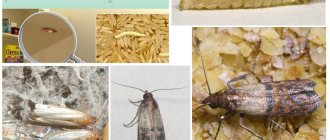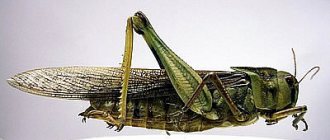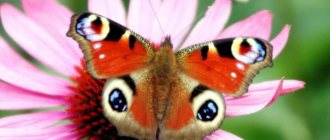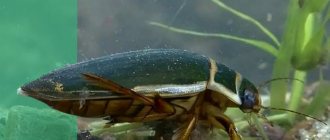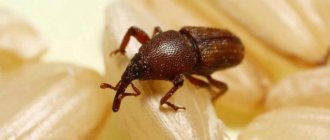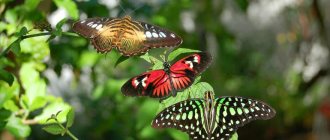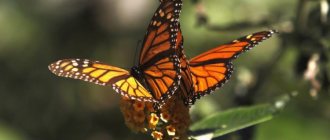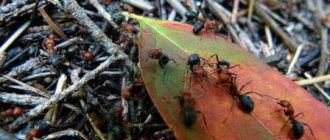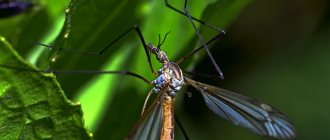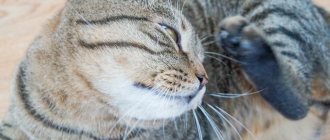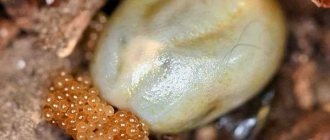Desert, extremely voracious
The desert locust is a very voracious insect, eating as much food as it weighs in a day.
In search of food, it flies at least 1200 km per day, although it moves only during the daytime, preferring to rest at night. A flock that attacks a field can spread over an area of 70-80 km, greedily destroying any of more than four hundred species of herbaceous plants and trees. "Desert" belongs to the family of true locusts. As the desert locust larvae mature, they acquire long, colorless wings with dark spots. Adults are yellowish or greenish in color depending on what stage they are in.
It is found in Asia Minor, India and some areas of Africa, and sometimes flies into the CIS countries from the territories of Iran and Afghanistan. This type of insect reproduces massively and cyclically, on average four times a year, producing four generations of larvae: two winter and two summer. The flock reaches its maximum number of individuals in seasons with heavy rainfall.
These insects can ignore most insecticides, which is why they are no less a disaster for agricultural areas than the Moroccan locust.
Important! The difference between the desert locust and its closest relatives is that it migrates not only periodically to search for food over long distances, but also annually to humid regions to reproduce.
Differences from grasshopper
To an uninformed person, locusts may look like grasshoppers. However, it has considerable differences: the first belongs to the locust family, suborder of the short-whiskered ones, the second belongs to the grasshopper family, suborder of the long-whiskered ones. Other differences:
- The grasshopper has longer whiskers and legs.
- The grasshopper is a predatory insect, the locust is a herbivore. However, there are times when locusts can eat a weakened fellow.
- The locust is active during the day, the grasshopper at night.
- The locust causes enormous damage to agriculture, while the grasshopper is absolutely harmless.
- Locusts lay eggs in the soil or leaves. Grasshoppers lay eggs in the bark of trees or in the stems of plants.
Varieties
Moroccan. A miniature insect about 3 cm. The main color is brick with brown specks. Habitats: Africa, Central Asia and Algeria, Egypt and Morocco.
Migratory or Asian - a fairly large representative (5 cm) of bright color (green, yellow, brown). This is a resident of European countries, as well as Asia, Northern China and Korea. Also seen in the southern zone of the Russian Federation, in the Caucasus and Kazakhstan territories, as well as in the South-West of Siberia.
Desert - rightfully considered the largest (8 cm). Habitat: North African countries, the Arabian Peninsula and the Sahara.
Italian. The length varies between 3-4 cm. Resident of Western Asia and the Mediterranean.
Rainbow is a 7 cm representative. It is quite poisonous, and this is the reason that this type of locust feeds. Beautiful and bright wings are literally saturated with toxins from poisonous plants.
Siberian filly. The color is gray-brown and gray-green. It grows up to 2-3 cm. It lives in the mountains of Central Asia and the vast Caucasus, and feels comfortable in the north of Russia, namely in Siberia.
Blue-winged - grows 2-3 cm. Its wings, bluish near the base, become transparent towards the end. Lives in the forest-steppe of Eurasia, the Caucasus and China.
WHAT DOES IT EAT?
Locusts usually live on the leaves and flowers of green plants. They use their strong upper mandibles to gnaw leaves, and use their smaller, weaker mandibles to crush them.
Since the locusts' mandibles move from side to side, the insects usually sit in the center of the leaf, on its longitudinal axis, and gnaw the leaf from edge to edge. Only a few species of true locusts feed exclusively on grass. The food for most locust species is the leaves of perennial plants, shrubs and trees. Some species of locusts can even feed on poisonous plants that other insects and animals do not eat.
Concentrating in their body, the poison provides insects with protection from enemies, since they themselves become poisonous. These locusts have bright colors, which warns of their inedibility.
Protection measures
To prevent and control locusts, the following measures are taken:
- To destroy the egg capsules of migratory locusts, deep plowing is used.
- To reduce the number of Asian locusts and reduce places suitable for laying eggs, a method is used to drain and further use the floodplains of rivers and lakes for growing crops.
- For chemical treatment of crops of various grain crops, in order to destroy the larvae, they are sprayed with pesticides: Karbofos, Fufan, Sumition, Sherpa; pastures and haylands are treated with the following preparations: Decis Extra, Fastak, Fury.
Reproduction and development stages
At the very beginning of the reproduction process, the males of these insects secrete and distribute a certain hormonal substance that has specific characteristics, which attracts females.
After this, the male connects with the female using the genitals and deposits a spermatophore at the base of the ovipositor. The mating process can last from two to twelve hours.
Important! Each type of filly has its own types of “songs”. Thus, the short-winged locust can make only four different types of sounds. After the female is completely fertilized, she begins to look for moist soil, where she lays eggs using the ovipositor
She makes small holes in the hole and places several eggs there at a time. One female is capable of laying from 50 to 70 eggs.
After the female is completely fertilized, she begins to look for moist soil, where she lays eggs using the ovipositor. She makes small holes in the hole and places several eggs there at a time. One female is capable of laying from 50 to 70 eggs.
In the process of laying them out, it releases a foam-like sticky substance, which contributes to the normal development of the future generation of locusts. Small locusts begin to appear after 12-14 days.
After the female finishes laying eggs, she leaves her offspring forever. Born locusts make their way through the soil layer with great difficulty, going through 5 immediate stages of development. Over the entire life cycle, a female locust is capable of laying eggs 6 to 12 times.
The stage of formation and growth of the locust embryo goes through an indirect development cycle (when the larva differs in external characteristics from adults). The indirect development cycle of insects is divided into two types:
- Complete metamorphosis. This type of insect development is also called complete transformation. With this form of development, the larva that hatches from the egg grows and develops for a certain period of time, and then turns into a pupa. During the pupal period, the insect is in a stage of complete rest. At this time, all vital organs in the young individual’s body completely change their structure. After some time, a fully formed adult insect emerges from the pupa.
- Incomplete metamorphosis. This type of development is precisely characteristic of locusts. Incomplete metamorphosis implies the absence of the pupal stage and the transformation of the insect from a larva directly into an adult insect. At the same time, locusts go through several biologically simple lines of development.
It acquires larger body and wing sizes. This is how huge herds are formed, which are subsequently capable of infecting various garden crops.
How do locusts reproduce?
Females begin laying eggs in late summer, in autumn. To do this, she makes a hole in the soil and lays her eggs in it. A special secretion is released from a special gland, which, like foam, fills all the holes between the eggs and creates a strong, reliable protection. Once hardened, the ovipositor appears in the shape of a long tube called an egg capsule.
One female makes several clutches, after which she dies. In European latitudes, the eggs spend the winter in the ground, and with the arrival of warmer weather, white larvae emerge from them. They are distinguished from their parents by their tiny size and underdeveloped wings. After a few hours, the larva acquires a characteristic color and begins to feed intensively. After 4-6 weeks, having undergone 4 molts, it turns into an adult.
In warm tropical climates, females lay eggs year-round and the number of generations per year can be 6-8.
Features of character and lifestyle
Photo: Large locust
The peculiarity of locusts is that they are able to live both on their own and in huge swarms. When the locust lives alone, it does not have a huge appetite and moves relatively little. It is not dangerous and does not cause much damage. As soon as the food runs out, the locusts try to lay as many eggs as possible, from which they will later hatch into gregarious individuals that can and will move long distances.
The offspring will be larger than their parents, their wings will be more powerful, which means they will be able to move longer distances. In swarms, locusts are very mobile and incredibly voracious. Flocks can number half a million. In order for the hatching of swarming individuals to begin, a deficiency of organic substances and amino acids must form in the locust’s body, and the reason for this may be a dry year and a lack of food.
A swarm of locusts is an organized system that moves purposefully at the call of fear and hunger. An adult can walk, jump and fly. However, her most efficient way of moving is by flying. A tailwind helps the locust move much faster, saving its strength.
Nutrition
Locusts feed on many types of plants, and unfortunately for people, they also feed on agricultural crops. This insect has an excellent appetite and the locust can force people whose crops have come under its terror to suffer from hunger.
She eats a large amount of food per day, approximately equal to her own weight. And the offspring of one individual is enough to eat enough grass in a season to feed two sheep. Fields, vegetable gardens, forests, meadows - all this can be eaten by a swarm of locusts.
The photo shows a swarm of locusts
Sometimes locusts also attack orchards - for example, they will eat grapes, starting with the leaves and ending with the bark and berries. The vegetation of reeds, reeds, hemp, flax, buckwheat, cereals - all this is used as food for the locusts. In addition, if there is a lack of food, it can attack the thatched roofs of houses, and on a long journey without food, it can eat its weaker brothers.
Types of insects
There are a huge number of varieties of locusts. It is impossible to list them all. Some of them include:
Types of locusts
- Moroccan (Dociostaurus maroccanus). Size up to 2 centimeters. Color – reddish-brown with small dark spots. It has a fancy pattern on the back in the form of a light cross. The small size of locusts does not protect crops from total destruction when a whole swarm swoops in. The damage to the land is colossal. For living, locusts have chosen Africa, Central Asia, Egypt, Libya, Algeria, and Morocco. Can be found in European countries.
- Desert. (Schistocerca gregaria). Locusts are distinguished by their large size. The length of the dirty yellow body of the locust can reach 8 cm. The brown wings have a large number of veins. They live in tropical and subtropical countries.
- Migratory. (Locusta migratoria). It is also called Asian. The body has a length of 3.5 to 6 cm. The color is green, brown, gray and yellow. The colorless wings have a smoky tint. Black veins are visible on them. The locusts chose Asian, European, and African countries to live in. This species can be found in southern and Siberian Russian cities, in the Caucasus, and Kazakhstan.
- Italian. (Calliptamus italicus). The peculiarity of the locust is its small body size, its wings are powerful and well developed. Color shades – red, brick, brown, brown, faint pink tones. Longitudinal light stripes and spots are visible on the wings. Habitat: Asia, Mediterranean.
- Egyptian. (Anacridium aegyptium). The female locust is distinguished by its large size. In males they are almost 1.5-2 times smaller. This species chose European countries as its place of residence. Color shades are discreet: gray, light brown, greenish-olive. A characteristic feature of the Egyptian locust is the presence of white and black stripes on the eyes. Representatives of this species are often found in the East, Europe, and northern Africa.
- Rainbow. (Phymateus saxosus). Very poisonous, brightly colored locusts live in Madagascar. The length of its beautiful body, iridescent with all the colors of the rainbow, is about 7 cm. It chooses the leaves of various trees as a shelter, including milkweed, the juice of which is poisonous.
- Siberian. (Gomphocerus sibiricus). A distinctive feature is the small size of the body (up to 2.5 cm). Color brown-brown, olive, gray-green. Widely settled in the regions of the Caucasus Mountains and settlements of Central Asia. Can be found in China, Kazakhstan. It causes significant damage to grain and hay meadows.
- Blue-winged. (Oedipoda caerulescens). The locust is very beautiful, its body size is small (up to 3 cm). The graceful wings are distinguished by a beautiful rich blue color, but at the base it becomes much paler, almost completely losing its color. Their surface is decorated with a beautiful pattern consisting of thin black stripes. The locust settled in the steppes and forest-steppes of European and Asian settlements; it can be found in the Caucasus, western Siberia, and Chinese lands.
Locust severity level
An omnivorous pest, with the greatest feeding activity in the early morning and evening hours, when there is no peak heat. One individual eats up to 500 g of plants with different densities of vegetative and generative organs (leaves, flowers, young branches, stems, fruits). Covers distances of up to 50 km per day. With a gap of 10-15 years, locusts form huge swarms (bands) of adults from united clusters of larvae. During the period of mass reproduction, they are able to simultaneously occupy up to 2000 hectares and fly, feeding on the way, up to 300, and with a fair wind, up to 1000 km, leaving bare ground with separately protruding remains of woody shoots and plant stems.
Under natural conditions, the number of pests decreases over time (the onset of cold, hunger, the work of natural entomophages). The number of diseases affecting the pest in different phases of development, starting from the egg phase, is increasing in the swamps. Recovery continues for 10-15 years and then the mass flight is repeated.
Locust behavior and reproduction
This type of insect has two phases in its life cycle: gregarious and solitary. Both phases have the same development period. First the egg appears, then the larva, the last cycle is the adult.
The females of this insect species lay their eggs in the ground. After some time, larvae emerge from the eggs. The larvae molt several times and after the final molt they develop wings. The imago stage begins. Experts distinguish 5 transformations of the larva.
The solitary phase of locust life occurs during periods when there is an abundance of food around. The single-stage filly has protective coloration and sexual dimorphism can be observed. At times when food is scarce, usually in dry and hot years, the female lays a large number of eggs. From them emerge larvae that are already programmed for the gregarious phase of life. From such larvae, it is not fillies that are born, but real locusts. It differs from fillies in its brighter and more contrasting coloring and the larger size of its wings and body.
At this stage, the locusts gather in huge swarms and move, as if on command, in one direction. The weight of insects in such clusters can reach several thousand tons. The locusts destroy all vegetation that is encountered along the way. In this regard, agricultural land may be severely damaged, which can lead to famine. Since ancient times, regions such as the African continent, Australia, southern Asia, America, where the largest locust invasion occurred, have been subject to locust invasions.
According to some reports, these voracious insects were able to cross the Atlantic. It turns out that even the waters of the ocean cannot be a barrier to hordes of locusts. If the wind is fair, insects can cover 500 km in a day. The largest swarm of locusts that could be counted contained 12.5 trillion individuals. This huge swarm covered an area of the earth of 513 thousand km. Such an incredible amount of insects weighed 27.5 million tons.
Of all plant pests, the most dangerous is the locust. If at your dacha there are corners with unharvested field grasses, you can always find a green locust there - a solitary locust, which over time will ensure the appearance of a winged form of locust. In 2000, an epiphytotic outbreak of locust breeding left the Volgograd region without crops (1000-6000 individuals per sq. m. area). In 2010, the pest reached the Urals and some regions of Siberia. The flight of locusts is terrible. Its flocks can number billions of individuals. When flying, they emit a characteristic sound that is frighteningly creaking up close and reminiscent of pre-storm thunder in the distance. After the locusts, bare earth remains.
What is the difference between a locust and a grasshopper?
A distinctive feature of this family of insects is their division into solitary locusts and gregarious locusts.
These species have external differences and lead completely different lifestyles, but they are just different phases of one insect.
Fillies are solitary, inactive insects. They are not prone to long flights and essentially do not pose a threat to the crop. But, during periods when the amount of plant food noticeably decreases and individual individuals are forced to share their usual habitat with numerous neighbors, insects completely change their lifestyle and form entire flocks.
Herd individuals are born within 1-2 generations. Such insects are much more active than their predecessors and have a truly “brutal” appetite. The color of the locust's body can change and acquire other, brighter shades. Swarms formed by such voracious insects can number more than 10 billion individuals and cover territories of several hundred kilometers.
Interesting Facts
Among the features of the structure and life of locusts, many interesting facts can be identified:
- Due to the fact that the insect has well-developed hind legs, it can move a distance twenty times its body size in one jump.
- When eating, locusts eat everything that is colored green. As soon as food that has greenish tints runs out in a closed room, the locust begins to eat its relatives if they are green in color.
- Insects can fly over vast spaces without landing - up to four hundred kilometers. The longest flight of a swarm of locusts is from the African continent to the islands of the Caribbean Sea. A herd of locusts walking on foot covers an area of twenty kilometers during daylight hours.
- 7,000 tons of citrus fruits were swallowed in 5 days by a community of locusts that attacked an orange plantation in Morocco. Amazing gluttony - one ton per minute.
- The locust is an insect that inhabits all continents of the globe, with the exception of Antarctica. This is due to harsh climatic conditions and a complete lack of food. But an interesting fact is that they are not available in North America. The last known locust outbreak on the continent was in 1875.
- The most unusual way to fight locusts was recorded in the 15th century in France. The judge who was considering the case of damage to the vineyards by insects made a decision to allocate them a plot of land, which the pests were strictly forbidden to leave.
- Locusts are on the menu of many peoples of the world. These insects are eaten in thirty-six countries located on the African continent, twenty-nine Asian countries and twenty-three countries on the South American continent. Research has proven that locusts are a nutritious food that can replace meat, they are low in fat and high in vitamins.
Where do locusts live?
Representatives of these insects can be found on any continent of the globe, with the exception of Antarctica. Locusts live in almost all climatic zones, from the tropics and subtropics to the vast expanses of Western Siberia.
Some types of locusts prefer to settle in areas that are covered with dense grassy thickets near water bodies. Other species live in desert and semi-desert areas among stone placers overgrown with sparse shrubs and grass.
Locust invasion
Citrus locust. Chondracris gosea
Insects and their friends No. 6 - Citrus locust - issue in Russia was published on 02/19/2014. In the first series of the Insects collection, the locust came out not as the 6th, but as the 81st issue, almost at the very end of the series. Now it came out at the very beginning.
Chondracris gosea. Insects up to 6.5 cm long. They live in Asia.
Representatives of this genus of grasshoppers are serious pests of various cereals, in particular sugar cane, rice and corn; they also harm citrus crops by eating their leaves.
Newly laid eggs are yellow, later darken, their size is 7-8 mm. The female lays eggs in the soil to a depth of 5-8 cm, the eggs are in a capsule. The female can lay up to 300 eggs.
The Locust is the LARGE specimen in the series.
Sample photo: Insects and their friends 6 – Citrus locust
Insects and their friends, several examples of the series, next to an 18 cm doll.
Among locusts, many species are dangerous pests of agricultural crops, so people have long paid attention to them. They are found almost everywhere where there is vegetation.
Their ability to jump delights children and adults, making them forget that they are one of the most voracious insects.
Due to their abundance and large size, locusts have become the basis of the diet of a wide variety of predators. These can be predatory insects, arachnids, and vertebrate animals - reptiles, birds, mammals. To survive, locusts learned to defend themselves and flee.
Insects up to 6.5 cm long, usually greenish in color, the lateral lobes of the pronotum with 4 yellow spots, the elytra are green, the hind wings are pinkish at the base and light green closer to the apex. The elytra extend beyond the apex of the abdomen. The hind tibia are reddish-brown with a black tip and yellow spines.
Locust
locusts are several species of insects of the true locust family (
Acrididae
), capable of forming large flocks (numbering up to hundreds of millions of individuals) migrating over considerable distances.
Locusts
(lat.
Acridoidea
) - a superfamily of insects of the order Orthoptera. They are the most numerous group of this order.
Like most orthopterans, locusts are famous musicians.
There are several types of locusts. Many locusts are agricultural pests.
About the magazine Insects and their friends + release schedule.
In number 5 there is a hornet.
Next issue: Insects and their friends No. 7 (+ Asian longhorned beetle).
CHARACTERISTIC FEATURES OF LOCUSTS
A characteristic feature of locusts is the peculiar structure of their hind legs. They allow insects to jump long distances. Like grasshoppers and crickets, locusts are excellent musicians.
— Habitat of true locusts
WHERE DOES IT LIVE?
Locusts are numerous throughout the world, often living in areas with rich vegetation. They are also found in semi-deserts.
PROTECTION AND PRESERVATION
True locusts are only threatened with extinction where their habitats are destroyed, especially in tropical rain forest areas. Some species are considered serious pests.
Features of names for boys
If we talk about the unusualness of Kalmyk names for boys, it is worth noting groups of words with certain identical directions.
- Names are amulets. They were formed through the names of plants, animals, household items, weather phenomena, and seasons of summer. Such words had their own sacred meaning, and in the modern world there was a rumor that they ward off evil power and adversity.
- The names are originally Kalmyk. These include rare beautiful Kalmyk names in (types of boys), denoting human qualities, state of mind, physical perfection of people's lives, numbers, names of heroes of the Kalmyk epic.
- Names with double roots. Subsequently, another root became the person’s patronymic.
- Names are distortions. These are phrases that were formed from the distortion of already existing names. In fact, the wife called her husband by a different name, changing several sounds, as according to legend, this led to the strengthening of the family.
- Planet names. They are formed through the words that denote the planets.
- Names-terms. Such phrases are most often derived from Buddhist terms.
Locust control methods
Given the speed of movement, gluttony and complete destruction of green plants along the route of the swarm of locusts, chemical control measures are used to destroy them, especially over large areas.
In a country house or local area, the fight against locusts is mainly preventive and proactive and begins with agrotechnical measures, the thoroughness and timely implementation of which helps to significantly reduce the number of pests and prevent epiphytotic damage to the green world of plants.
Agrotechnical measures
In areas prone to locust attacks, late digging of the dacha or house area is necessary, during which the egg capsules with locust eggs are destroyed.
When conducting alternative agriculture, it is necessary to tinn unused areas, which prevents the formation of egg capsules and the laying of eggs by female locusts.
Chemical control measures
It is better to carry out all chemical treatments in the morning. When working, observe personal safety measures, work in an appropriate suit, respirator, goggles, and gloves. When working with chemicals, it is necessary to strictly follow the guidelines for the dilution and use of pesticides.
If there is a large accumulation of locust larvae in certain areas, it is treated with Decis-extra, Karate, Confidor, Image, the validity of which lasts up to 30 days. Can be treated with all drugs that are used to combat the Colorado potato beetle.
The systemic insecticide Clotiamet-VDG provides plant protection against locusts for up to 3 weeks. After 2 hours, all pests die, and the number of live hatched larvae decreases noticeably. The drug can be used in a tank mixture with fertilizers and growth stimulants, subject to mandatory compatibility testing.
Insecticide Gladiator-KE effectively removes larvae and adult locusts. Used in the early hours, when adults are in a daze. Doses of the drug vary depending on the age of the locust.
Damilin is an insecticide with a unique effect on the growth of the pest and the formation of chitin in the body of the larvae during molting. As a result, the larvae die before reaching the age of the adult pest. Valid for up to 40 days. The drug is low-toxic for humans and warm-blooded animals, and quickly decomposes in water and soil.
Such a voracious insect as the locust has an enviable appetite and is capable of leaving behind fields with the remains of plants eaten at the roots, bushes and trees without branches and bark, pathetic tails of former watermelons and pumpkins, bare vines of a once blooming vineyard. To make such devastating raids and grind everything in your path, you need to have a very powerful oral structure.
“And the locusts came upon all the land of Egypt.” Desert locusts strike Africa
January 23, 2022 at 07:36 TUT.BY
Swarms of hungry locusts are approaching the countries of East Africa. They have already “occupied” Ethiopia, Kenya and Somalia. Next up are Uganda and South Sudan. The UN fears that this will cause serious food problems in the region in the near future.
Local residents try to drive away locusts with sticks in the village of Lemasulani in Kenya. January 17, 2022. Photo: Reuters
“The current situation is gaining international proportions and threatens the food stability of the entire subregion,” said Qu Dongyu, Director General of the UN Food and Agriculture Organization (FAO). He said FAO is stepping up efforts to support governments in organizing a collective campaign to combat this crisis.
Desert or African locusts in the village of Lemasulani in Kenya. January 17, 2022. Photo: Reuters
The desert locust or African locust is perhaps the most dangerous pest of the entire locust family, mainly due to its extreme gluttony, high speed and range of flights of colonies, and the intensity of reproduction.
In calm years, when these insects have enough food, they lead a solitary lifestyle. But when there is a threat of famine due to major crop failures, desert locusts gather in huge colonies numbering tens of millions of individuals and begin to look for food in remote areas.
A farmer holds desert locusts in Nakwamuru village in Kenya, January 16, 2022. Photo: Reuters
In a day, one insect eats as much as it weighs - about 2 grams. A ton of insects, which usually makes up only a small part of a swarm, eats as much as 2.5 thousand people per day. A swarm of locusts moves at speeds of up to 150 kilometers per day.
A swarm of desert locusts flies over a grassland in the village of Nakwamuru in Kenya, January 16, 2022. Photo: Reuters
Ethiopia and Somalia have not experienced such massive desert locust outbreaks in 25 years, while Kenya has not faced a threat of this magnitude in the last 70 years.
A man sprays an organic pesticide on locusts, showing its immediate effect. This is the only way to control the locusts and prevent the infestation from spreading. Riandira village in Kenya, January 14, 2022. Photo: Reuters
Locusts are not easy to control. Areas that have already been affected or may be affected by locust infestations are sprayed with pesticides. In those places where help has not reached, farmers are trying to disperse the locusts as in ancient times - with sticks and loud noise. The effectiveness of such measures is close to zero.
A swarm of desert locusts flies over the village of Nakwamuru in Kenya, January 16, 2022. Photo: Reuters
Experts warn that if urgent action is not taken, the number of crop-eating insects could increase 500-fold by June.
Desert locusts in Nakwamuru village in Kenya, January 16, 2020. Photo: Reuters
The insect invasion began in Yemen, where, since the beginning of last year, natural conditions have been created for the rapid reproduction of the desert, or African, locust.
From Yemen, desert locusts rushed in two directions last fall - to Africa and to Hindustan. Having flown over the Red Sea, the insects arrived first in Ethiopia. They have also appeared in Djibouti, Eritrea, Kenya and Somalia.
A difficult situation also developed in Pakistan and India, which were also hit by locusts from the Arabian Desert - but not on such a scale.
Locusts in the village of Lemasulani in Kenya. January 17, 2022. Photo: Reuters
Countries affected by locust attacks are already taking action to combat locusts, but due to the scale and imminence of the threat, they need financial support from the international community. The FAO said it was ready to help. At this stage, based on preliminary estimates, the organization is asking for $70 million to be allocated for these purposes.
A car drives through a swarm of desert locusts in Galmudug, an unrecognized state in central Somalia. December 22, 2022. Photo: Reuters
Sermons in African churches are now incomplete without quoting the book of Exodus: “And the locusts fell upon all the land of Egypt, and lay throughout all the land of Egypt in great multitudes: there had never been such locusts before, nor will there be such after this.”
But the parishioners are more frightened by the Revelations of John: “And out of the smoke came locusts onto the earth, and they were given the power that the scorpions of the earth have. And she was told not to harm the grass of the earth, or any greenery, or any tree, but only to people who do not have the seal of God on their foreheads. And she was given not to kill them, but only to torture them for five months; and her torment is like the torment of a scorpion when it stings a person.”
A girl tries to ward off desert locusts from her farm near the town of Jijigi in Ethiopia, January 12, 2022. Photo: Reuters
In fact, locusts are not dangerous to humans, but they are dangerous to Africa as a whole.
“Insects will soon reach other countries in the region, which is fraught with serious economic and humanitarian consequences,” the UN predicts.
Translated into human language: the region is threatened by famine.
Desert locusts in Nakwamuru village in Kenya, January 16, 2020. Photo: Reuters
Locust description development
Field grasshoppers, or locusts (Acridiodea), are the most harmful to humans; they can jump very high to a height exceeding more than 200 times the length of their own body. The locust has a laterally compressed body, a large head, a protruding forehead, and simple eyes are not always present; lips are very pressed to each other; the upper and lower jaws are well developed; the abdomen is almost fusiform, slightly flattened at the top, all 4 wings are approximately the same length, but the front ones are wider than the rear ones
A very interesting device is placed on the first segment of the abdomen on its sides, which, according to Muller and other scientists, is a kind of hearing aid. It consists of two dimples, which are surrounded by a horny ring and covered on top with a thin leathery chitinous membrane. Underneath there is a small, delicate blister filled with fluid, and this blister is in connection with the nerve ganglion.
The superfamily Locust includes many species that are very dangerous pests of agricultural crops, especially grains. They are often confused in appearance with grasshoppers. They differ from grasshoppers by short antennae (shorter than half the body) and three-segmented legs.
Countermeasures
To prevent agricultural disasters, the number of insects at different stages of development of migratory locusts is monitored in breeding areas.
Such accounting makes it possible to predict the appearance of the gregarious form and apply insecticides in the phase of population growth, including barrier treatment of nesting sites.
The biological enemies of locusts are insectivorous mammals and birds (especially starlings), as well as some fungi that are pathogenic for orthopterans.
Agrotechnical prevention of the growth of the Asian locust population is:
- Drainage of floodplains of rivers and lakes using them for agricultural plantings.
- Improvement of pastures by mass sowing of forage grasses. The soil, densely entwined with roots, becomes unsuitable for laying eggs.
- Deep plowing of areas infested with locusts, turning over the earth layer and harrowing.
- Spring disc loosening along roadsides and slopes of irrigation canals.
Asian migratory locust (family name - locusts), type of development - indirect. During the period of mass reproduction, this pest poses a real threat to all agricultural crops.
The rise in the number of these insects can be prevented by agrotechnical and biological prevention, as well as timely treatment of breeding sites with insecticides.
Phases of development
As has already been noted, locusts have two development options: solitary and gregarious, which are strikingly different from each other.
Single cycle
The locust filly, as single individuals are called, develops freely with an abundance of food and leads an inactive, shy lifestyle, which is why it was previously systematized as a separate species. Single individuals are characterized by camouflage coloration and pronounced sexual dimorphism. The filly does not cause significant harm.
In fact, a single phase of locust development is necessary for the preservation of the population. The female lays eggs and when the food supply becomes insufficient to feed all the larvae, the locust moves on to another stage of development.
Herd development
Association in swarms is observed in hot, dry years, when locusts begin to experience a shortage of food and moisture. According to recent studies, a lack of protein provokes females to intensively lay so-called “campaign” offspring.
Gathering into a large tribe, intense friction against each other, the visibility of their own kind, the smell of fellow tribesmen causes a powerful production of serotonin in the nervous system.
Due to the release of the hormone, individuals literally undergo dramatic morphological changes in a matter of hours:
- change of color;
- increase in size;
- leveling sexual dimorphism.
Clusters of adult flying locusts are called swarms; the larvae form swarms. The population moves, as if on command, in one direction. Weakened individuals are eaten along the way by their fellow tribesmen. Adult locusts are capable of long flights and cover from 90 to 140 km per day.
The locust invasion cannot go unnoticed. The sound of approaching insects is comparable to the sound of thunder, and the flock itself covers the sun.
On its way, the flock devours literally everything, even the thatched roofs of houses, vineyards, orchards, vegetable and grain plantations. Just decades ago, locust attacks caused famine. Now the flocks are causing colossal losses to farmers. In 2015, a locust invasion in Russia destroyed an area comparable to the territory of an entire state, for example, Romania.
What external data
Locusts are also commonly called locusts. The insect belongs to the order Orthoptera and the family of true locusts. The name of the creature originates from the Turkic language. Translated, this means yellow.
There are different types of locusts
The color of the insect itself is not only yellow. Color ranges from olive to brown. The shade directly depends on:
- age of the representative;
- habitats;
- subspecies
The coloring of the insect is intended for camouflage. It is for this reason that color strongly depends on where the parasite lives.
The body length of the insect is 1-25 cm. The head is large. There is a powerful jaw apparatus. Large eyes are observed on the sides. The wings are transparent. Dense elytra are observed from above. Females are larger than males. Female representatives have a sharp ovipositor.
Males make a specific sound. This is due to the presence of notches. They are located on the thighs of the hind legs. The locust life cycle includes 2 phases. This is a solitary and herd lifestyle.
Read on topic:
Features of the life activity of ladybugs
14.11.2020
Description of chironomids and their possible danger to humans
14.11.2020
What do cutworms look like and what harm do they cause?
14.11.2020
What do goliath beetles look like and can they be bred at home?
14.11.2020
This is a fairly large insect
Varieties of insects of the "true locust" type
The Asian locust is a fairly large species of pest.
An adult male reaches from 35 to 50 mm, a female from 40 to 60 mm. These locusts come in shades of green, brown, gray and yellow. The transparent wings are pierced with black stripes. The paws are colored in dark blue or dark brown shades, combined with beige, scarlet and ocher. This pest is common in Europe, Korea and China, on the African continent and in Kazakhstan. In our country, this insect lives in the Caucasus mountains and Western Siberia.
The blue-winged filly is a medium-sized pest.
The body of an adult female filly is 22-28 mm, the smaller male filly is 15-21 mm. The wings, celestial at the points of attachment to the body, become transparent towards the tips. The wings are covered with thin stripes that form a beautiful pattern. The hind legs are covered with spines and colored light blue. This pest lives in the forests of Europe and Asia, the Caucasus and Central Asia, Siberia and the territory of the Chinese state.
The Egyptian filly is one of the largest pest representatives in the European part of Eurasia.
The female individual reaches 65 - 70 mm, the male - 30 - 55 mm. The color of the insect can be green, grayish, or light shades of brown. The hind limbs are colored blue and orange, with characteristic black dots. Black and white stripes are located in the eye area. This type of locust lives in the East, in European countries, in the northern part of the African continent.
Italian locust.
The length of this type of male pest is from 14 to 28 mm, the female one is 40 mm. This pest is endowed with well-developed wings. You can find Italian locusts in brick, chocolate, and soft pink shades. Light stripes and small light spots are visible on the body. The thighs are pinkish in color, and the lower legs are red or white, covered with dark stripes. This pest lives in the Mediterranean, Central Europe, Western Asia, Iran and Afghanistan, Western Siberia, and Altai.
Moroccan locust is small, up to 20 mm.
This type of locust has an unusual cross-shaped pattern on its back. The insect's body is colored in shades of brown, covered with small dark spots. The hind limbs are colored in shades of yellow, salmon and red. This type of insect causes great damage to agricultural crops. This is a tiny insect found on the Eurasian and African continents.
Desert locust.
Traditionally, this pest is large in size. Representatives of the female half grow up to 80 mm, males - up to 60 mm. This pest is dark yellow with chocolate-colored wings, and the hind limbs are lemon-colored. This pest lives on the African continent.
Rainbow locust.
This pest grows up to 70 mm. This insect is extremely dangerous due to its toxicity. This is due to the fact that representatives of this species eat poisonous plants, for example, such as milkweed. The pest's body is painted in different colors and looks like a rainbow. Hence the name. This species lives in Madagascar.
Siberian filly.
The female specimen is no more than 25 mm in length, the male specimen is up to 23 mm. The body is painted in shades of chocolate and grass colors. This pest is found in the Asian and Caucasian mountains. In our country, a representative of this species is found in Siberia. The insect destroys crops and meadows.
What types of locusts can be found in Russia
The number of locust species is simply huge and some of them can be found in different regions of Russia. The most common among them are:
- Moroccan locust;
- migratory Asian locust;
- desert locust;
- Italian locust;
- Siberian filly;
- Egyptian filly.
Locust: types.
